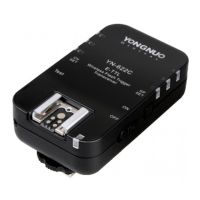The Other YN-622C User Guide
28/08/2013 Page 2 of 23
INTRODUCTION
What we know gets in the way of what we could know.
I have used Canon’s Flash Control menus for 5 years, appreciating being able to control remote
flashes from the camera. Well, sort of. Canon has been using an optical pulse “wireless” command
system for off-camera flashes, which works within a limited set of conditions.
Pixel released their King triggers to remove this limit, but their development was truncated.
However, kudos to Pixel for pioneering this category of trigger/controller.
Now we have the Yongnuo YN-622C which seems to fulfil the promise of a full implementation of
Canon flash technologies over a radio link. It seems that Yongnuo has not only achieved this
objective, but has added a wide range of triggering and photographer-friendly capabilities.
Yongnuo have had a range of hot-shoe flashes, with a degree of unreliability. The design engineer
for this device looks like single-handedly rescuing the brand.
The YN-622C is a transceiver type radio device designed to go between a camera and one or
more off-camera flashes, to provide:
• E-TTL, FEC & HSS off-camera triggering
• Radio control of off-camera flashes from camera flash control menus
• General-purpose triggering
There is much (unnecessary) debate about the merit of TTL flash exposure versus Manual power
levels. Each method has its place, and photographers who understand the technologies can get
predictable results. The YN-622C is a tool for both approaches.
One part of Canon’s E-TTL is often misunderstood – Ratios. It is more than setting an FEC or EV
adjustment on two flash groups. That still leaves distance, height, angle, relative powers, uneven
ambient etc that can make a substantial difference. Canon’s ratio evaluates the actual contribution
to the image of each group of flashes, and sets the level accordingly. It is much more accurate
than the EV method. The YN-622C implements the genuine Canon technology in the camera.
The YN-622C does not provide for firmware updates by the user. Canon Wireless Master/Slave is
not available, being replaced by the 622 procedures. The transceiver buttons are hard to find by
touch, and are sensitive to accidentally changed settings. Only flashes in group C can be disabled
remotely. It is not a significant list of drawbacks.
An examination of the case and internal components reveals a high-quality assembly. The case
appears firm. I anticipate a good life expectancy.
Because the YN-622C is designed primarily to implement Canon technologies, a thorough
knowledge of both camera and flash manuals is helpful. Each camera model has its own
variations.
My verdict: versatile, complex, well-made, suitable for many jobs, and low-priced. Buy it.
The author has no association with the manufacturer other than as a paying customer. Some additional
samples were received; thanks, Yongnuo. The main testing equipment was EOS 50D, 7D and 6D;
Speedlites 580EX II, 430EX II and 550EX; Yongnuo YN-622C triggers; Pixel Soldier as a radio shutter
release.

